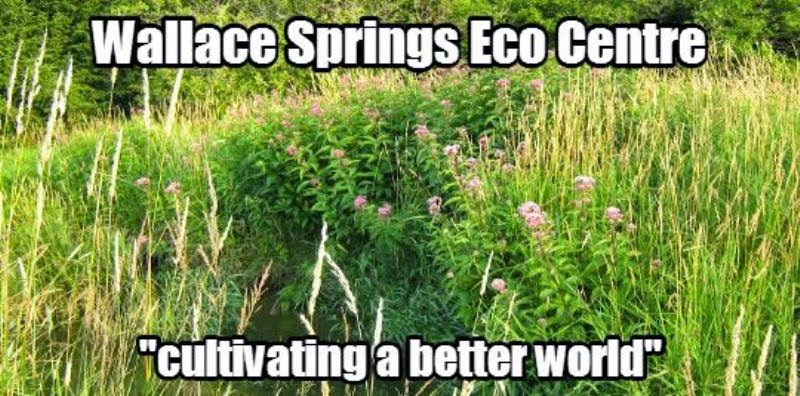Our contribution is the land (current market value, approx. $250,000.00), a significant portion of the seed, shrubs and trees that we have available, and labor (but I am only one person). The development will proceed at the speed of which funding is available. So said, your ideas, suggestions, recommendations, and referrals are appreciated. Donations to help with seed/seedstock and seeding can be made at via the "Building Wallace Springs Insectory fund" button here Thanx
 |
| "The Before" picture - courtesy Google Streetsview |
 |
| Wallace Springs Insectory, conceptual plan |
THE DESIGN:
There is a considerable opportunity to build biodiversity into this site, especially in the cropland that is about to be retired. The Permanent Milkweed Plot will provide a substantial feeding and larval resource for Monarch Butterflies. The many plants described in the foregoing will aid the land owners to create a high level of biodiversity with a mix of habitat types for pollinators as well as pure stands of flowering plants.
At the entrance to the site from the township road a formal garden area with pathways will have beds of showy flowering nectar plants and milkweed with labels so that people know what these are and they would be educated at once as the entered the Insectory. As users progress into the site they will be exposed to more complex habitat types that incorporate these showy plants and others so there will be more biodiversity to the site that will benefit both butterflies and song birds. This design approach will show people how plants favorable to butterflies can be found in many types of habitat in Ontario and they can be used on their property from flowerbeds to riparian plantings to hedgerows.
People will see how maintaining pollinator habitat is important and that there are plenty of opportunities with a range of habitats that could be suitable for their property especially lands that are marginal for agriculture and that they might consider retiring for conservation to build biodiversity and ecological resiliency.
It is important to remember that humans depend on biodiversity for the necessities of life. For example,biodiversity provides us with clean air and water and the fertile soil in which to grow the food we eat.Conserving Ontario’s biodiversity is key to ensuring a healthy environment, strong communities and athriving economy.
Biodiversity is the foundation upon which we derive benefits called ecosystem services. These benefits can come from species, such as bees that pollinate crops, or from a complex ecosystem, such as a wetland or riparian area that provides habitat, absorbs carbon, and cleans air.
The use of a high variety of plants for this project will allow for greater range of pollinators to use this site and to make it a highly valuable resource for the local ecosystem and for environmental education in the Maitland River Watershed
Phase I will include those lands north of the Maitland River.
This work is intended to be implemented in 2015. Individual components include a Permanent Hay Crop with grass species including Rye Grass, Orchard Grass, Panic Grass, Tall Fescue and Timothy. The Permanent Milkweed Plot will be a single species planting of Common Milkweed (Asclepias syriaca).
There will be a hedgerow between the former area and the pollinator plant beds; this will consist of a variety of shrubs as listed above.
The Pollinator Plant Beds will consist of both mixed species and single species plots. A mown trail will wind around through the plant beds to allow for access for visitors. Any flowering plants from the former
list may be used. Demonstration Pollinator Plots at the entrance will allow the owner to highlight those plants that have the highest pollinator potential at this site.
At the entrance and at the central Information Centre there will be interpretive signage to educate uses with regard to the project intent, the types of plants found here and the role and value of pollinator species for the natural environment and human kind in general.
PHASE II - SOUTH OF THE RIVER
Phase II will include those lands south of the Maitland River.
This work is intended to be implemented after 2015 as funds and other resources allow.
This project, the Wallace Springs Insectory will provide a valuable educational resource for the Maitland River Watershed, the Town of North Perth, Perth County as well as those reached in the "virtual" world. It is important to assist in changing attitudes toward the ecological role of milkweeds for the Monarch Butterfly. It is also important for emphasizing the need to protect and foster pollinator species in rural areas where pesticides are used heavily and pollinator habitat has been greatly diminished.






